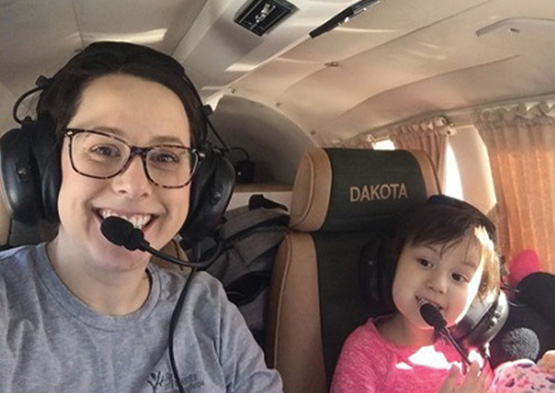Volunteer Pilot Shares the Impact of an Angel Flight NE Mission

Each & every day we are inspired by our amazing supporters, partnerships, patients & their family members! Today, however, we want to reveal a narrative shared with us by one of our amazing volunteer pilots!
We have featured Maci & her wonderful family on numerous occasions – including our Annual Evening of Angels Gala video. Maci was diagnosed with Neuroblastoma on August 10, 2019 (at only 21 months old) – since that date, she has gone through much more than most people could imagine. Her family continues to have an amazing perspective & Maci has done extremely well with her treatment thus far!
Thom H., based in Ohio, shared the following after a recent trip flying Maci & her mother home:
“One year ago, almost to the day, I flew Maci and Mom. My wife was with me on that trip, her first Angel Flight mission. After Maci and Mom were delivered to a crowd of crying, balloon, and sign waving family members it was our turn to cry and pray for a young family we had just met. Though Mom is all thumbs up, her fear for Maci could not hide behind the mask.
This time, I flew a vibrant little lady with the energy and glow all four-year-old’s should have, and a mom excited for Maci’s future.
I am tempted to print these pictures and carry them with me. When asked why I fly Angel Flight missions, then all I would need to do is show them. No words needed.”
Stories such as these – breathe life into our office & spark our passion to continue to do such important work.
As with all our patients & pilots – they are forever a part of our Angel Flight NE family. We are privileged to have the opportunity to not only fly but deeply care for all who turn to us for help at difficult times in their lives. With pilots like Thom, we can aid patients for as long and as frequently as they need our help and to ensure the best possible outcome.
Maci has a long road ahead of her, but Angel Flight NE is here to help her along the way. We are forever grateful to our supporters that allow us to help in the most stressful of circumstances.
Please keep Maci and her family in your prayers for her continued treatment and recovery. And keep our amazing volunteer pilots, earth angels / ground crew, staff, sponsors, and supporters in your prayers also. Together, we are transforming the lives of our patients and their families.
Thank You and God Bless You for your support and belief in our healing mission. With your help and belief in our mission, we can ensure that distance is never an obstacle for patients, like Maci.
Warmest regards,
Fr. Larry & the AFNE Staff
 Pilot Login
Pilot Login 